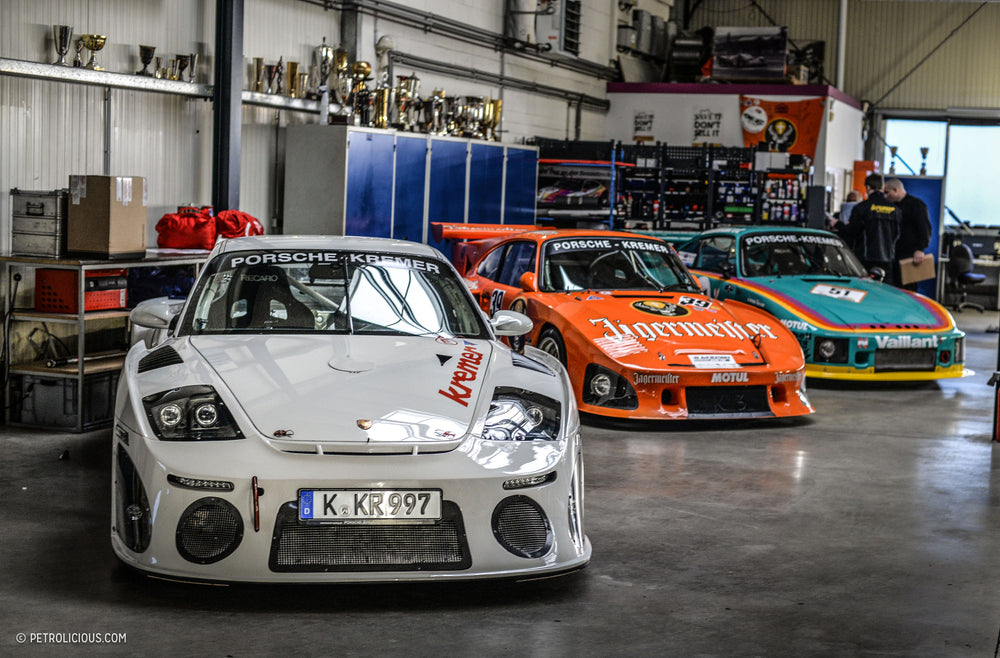In Germany, there are many places to visit, especially if you’re the kind of automotive archaeologist that digs Porsche’s racing history and the teams and garages that brought them such success. And if you find yourself in Cologne, the first name on your list should be Kremer Racing, the team that defined Porsche’s racing success in the ’70s and ’80s as a factory-backed crew as well as an independent.
Erwin and Manfred Kremer, two brothers born in Cologne, founded Kremer Racing in 1962 after strong careers of their own as international racing drivers who were already modifying Porsches to their requirements. Their goal was to establish their own racing team, together with developing and modifying the factory’s best offerings in the field of motorsport, making them even better, improved, evolved if you will. This led to the Le Mans-winning K3, among many others, and earned the brothers their reputation as something beyond simply “tuners.” Occasionally they operated as a factory-backed team, but really, they were all about the independence and chasing their own goals while winning every race they could, which they often did.





It all started with 911s, 914-6 GTs, and 934s, modified by the brothers to different specs using only the best equipment and partners, or just machining it themselves. Later on they decided to not only develop and race those creations under their own banner, but made their legendary cars available to other race teams with less technical know-how.



Things started to get really serious when a collaboration between DP Motorsport and Kremer resulted in the aforementioned K-Series. The K-Series was based on Porsche’s infamous 935, and is numbered chronologically—K1, K2, K3 and so on. The Porsche 935 is my absolute favorite Porsche racing car, and the Kremer K3 is one of the most captivating and successful variants to hit race tracks and sweep up anyone else who happened to be on them.





The beautiful, radical bodywork made out of fiberglass and designed by DP’s Ekkehard Zimmerman, when paired with Kremer’s turbocharged weapons system in the rear, resulted in one of the most successful Group 5 race cars of all time. The iconic bodies were all made by hand in-house at DP Motorsport, another of the great Porsche garages that we will be diving into in the near future.
So, you claim to be a car enthusiast, maybe even a Porsche lover and a student of racing history? Well you must have heard of this famous beast! You all know Jägermeister, and you really should know the Jägermeister K3, that fabled car that would become one of Porsche’s most iconic altered silhouettes. Besides being a total looker, the K3 was just plain quick. A truly mental beast, a balancing act of high technology and brute force, and one of the very few cars that would defeat the prototypes at the 24 Hours of Le Mans when the Whittington brothers and Klaus Ludwig drove a K3 to overall victory in 1979.






I had the pleasure of revisiting Kremer a few weeks ago, and I felt right back at home. I have not been back since I moved away for my engineering degree and I must admit that I truly missed these beauties and the atmosphere of racing they carry with them even when parked and silent. I used to work for Kremer Racing, and I very much enjoyed my time there, especially looking after some true beasts like the K2 and K3 during the many historic races the cars still compete in.
The first thing I did on my return visit? Well as you can probably guess, I found myself behind the steering wheel of my true love, the Jägermeister K3, just to say “Hello” again inside the shop before taking it out for a quick spin. I was smiling like a four-year-old who’s just received a lollypop, and still I can’t stop daydreaming about what it would be like to drive this car on the Nordschleife, spitting out fire and pure noise, one hell of a time that would be!




Sitting in it is the next best thing to driving, and the first thing that jumps out while hopping into this machine is how spartan it all is, yet still comfortable in its own way—the custom fiberglass heel plate for instance is perfectly aligned and ergonomic, a must in endurance racing. But the real excitement of course is to be found in the back, where you’ll see the exposed KKK turbochargers, claiming to deliver 800hp to the rear wheels depending on the tune.One of the many improvements which helped them outperform even Porsche’s factory teams was their air-to-air intercooling system, which they switched from the factory air-to-water units in order to receive better cooling and a more consistent power output.I loved having the rare opportunity to take it out for a short drive as well, something that I won't ever be able to forget.







After managing to separate myself from the K3, I got to admire the rest of the fleet like the Vaillant-liveried K2 and the Kremer 997-based street legal K3 just to name a few. I took a full facility tour, which ended in the office where I had the rare opportunity to go through old archival material featuring the development of these vehicles.








Enough background information for now, and if you’d like to see these cars in person, in action, I invite you to attend the AvD Oldtimer Grand Prix at the Nürburgring later this year in August, as both the K2 and K3 will be racing there and throwing us all back in time. Until then, enjoy what I captured at the garage and last year’s Retro Classics Cologne!




















































